German potato pancakes are true comfort food. Easy and quick to make, crunchy at the edges and soft in the middle. Serve them with applesauce and sour cream for an ultimate treat.
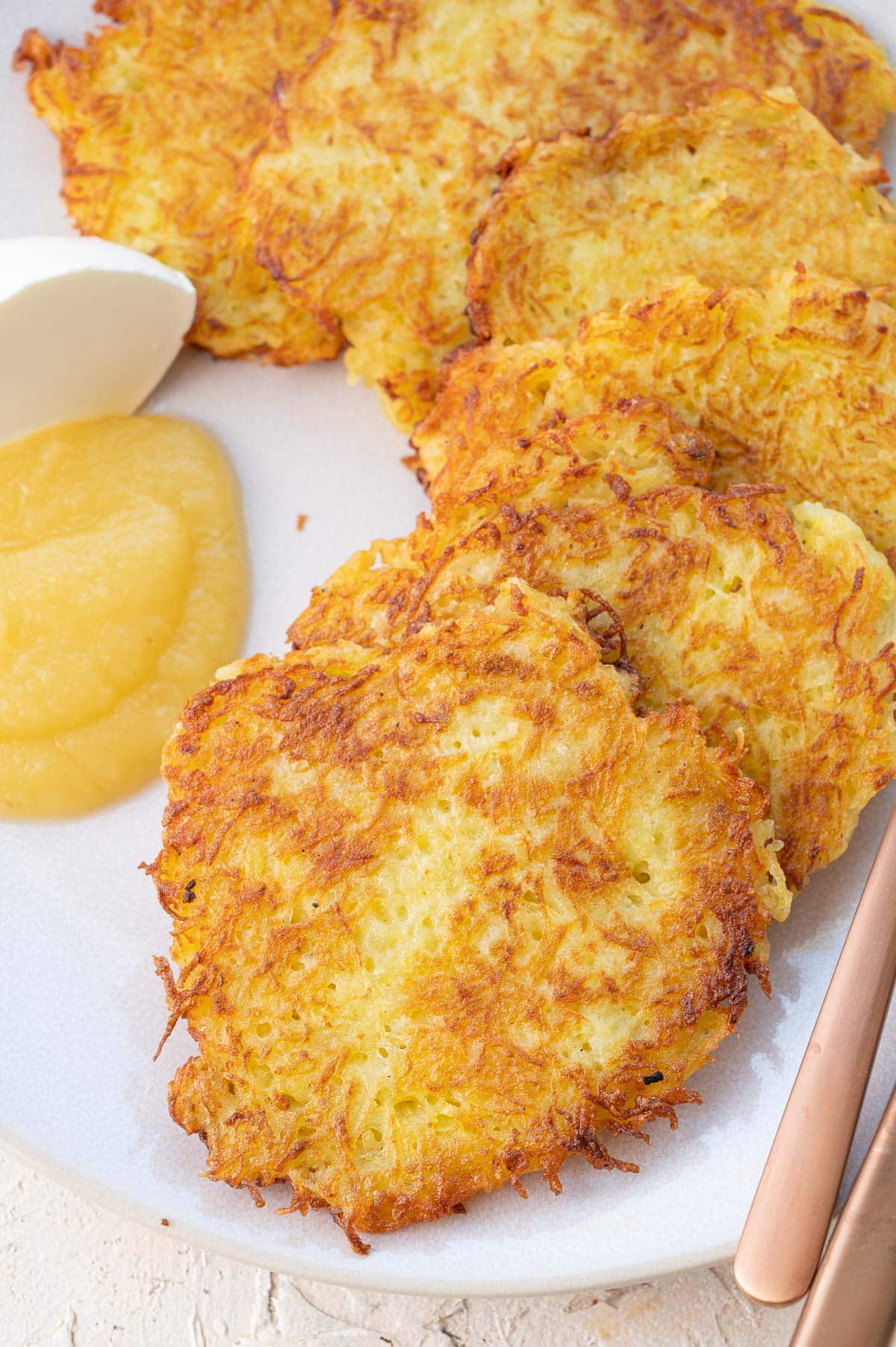
What are German potato pancakes?
German potato pancakes are pancakes made from grated raw potatoes, grated onions, egg, and spices. They are fried in a pan and are super crunchy. They are very popular in Germany, German-speaking countries, and neighboring countries. They are served as a snack or as a side dish.
In German, they are called Kartoffelpuffer, Erdäpfelpuffer (in Austria), or Reibekuchen which means “potato puffs” or “grated pancakes”.
You may notice they’re pretty similar to Jewish potato pancakes (Latkes) or Polish potato pancakes (placki ziemniaczane) and it’s true! There are a couple of small differences between them but it’s a pretty similar dish. No wonder so many European countries love their potato pancakes – they’re simply irresistible.
Ingredients
Here’s what you need to make German potato pancakes (Kartoffelpuffer):
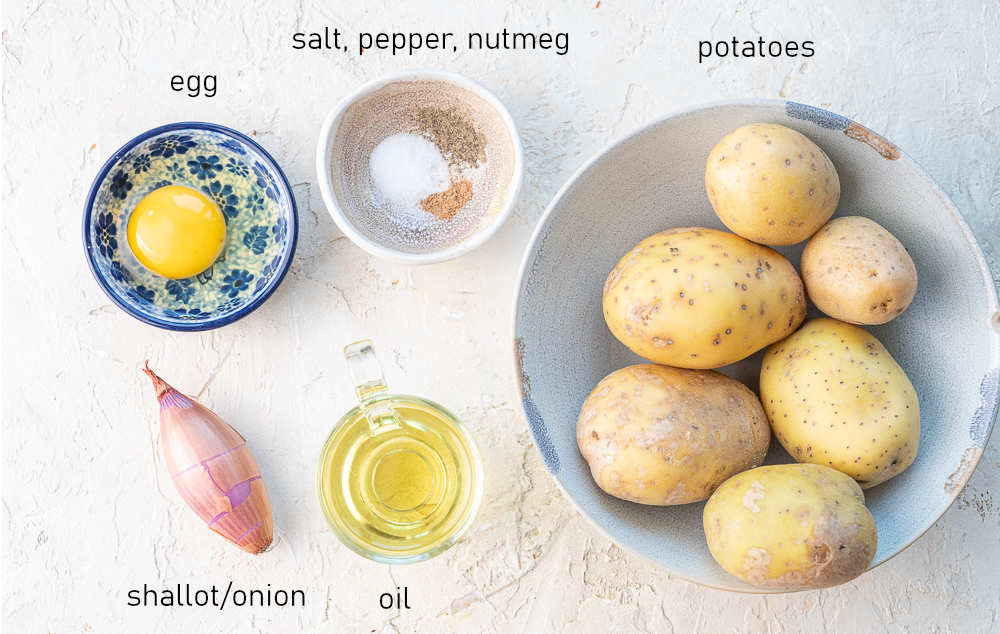
Potatoes – The best potatoes for potato pancakes are starchy/mealy potatoes such as Russets and the second best are all-purpose potatoes such as Yukon Gold potatoes. They don’t release much water and make crispy pancakes that are not oily. Russet potatoes are super starchy which helps bind the ingredients and don’t release much water which makes them crispier and causes they don’t absorb so much oil. They make great pancakes.
Do not use waxy or young potatoes as they are very watery. Watery potatoes are the worst kind of potato to use for these pancakes.
Onion – can be omitted but I really recommend adding it!
Egg – binds the ingredients but you can omit it if you want to make your potato pancakes vegan or if you just run out of eggs. Just add some potato starch to the pancake batter.
Nutmeg – typical seasoning for German potato pancakes.
Potato starch/flour – I prefer to add the potato starch that was naturally released while grating the potatoes (it will be at the bottom of the bowl with the liquid left from draining the potatoes). Potato starch binds the pancakes better than flour and in addition, they taste better (have more ‘potato flavor’). If you have forgotten to reserve the water from squeezing the potatoes and you don’t have the potato starch, you can add about 1 tablespoon of store-bought potato starch to the batter. Don’t add corn starch, the flavor of corn doesn’t work well here and the potatoes will have less ‘potato flavor’.
Salt and pepper – don’t skim on the pepper!
Frying oil – must have a high smoke point, which means it can be heated to a high temperature. Any high smoke point vegetable oil will do. Alternatively, use lard or clarified butter. Do not use regular butter as it’s not suitable for frying and it will burn too quickly. Olive oil also can be used – it would be better to use olive oil that is suitable for frying, not extra virgin olive oil which is more expensive and perfect for salads.
What you could also add: I’m giving you a basic/classic recipe for potato pancakes but you can modify it freely or add other seasonings to make them more interesting. You can season your pancakes with: garlic powder, paprika, onion powder, Italian seasoning, fresh chopped parsley or dill, or even Parmesan cheese.
How to grate potatoes for potato pancakes?
This depends on your preferences, how do you like your potato pancakes – more like pancakes or more like fritters?
- potatoes grated on the small holes of a box grater – are softer and their center is more creamy, this kind of pancakes is more traditional, this is how my Grandma is making them
- half of the potatoes grated on the small holes and half on the big holes – these pancakes are still soft and ‘pancake-y’ in the middle but super crispy on the edges – a really good option
- potatoes grated on the big holes of a box grater – less traditional, taste more like fritters, are super crispy but require more cooking time to be cooked through in the middle
You can grate the potatoes by hand (this is, unfortunately, the best option) or with a food processor. I don’t recommend pureeing the potatoes in a food processor/blender so that they almost resemble a mash, although some people prepare them this way. Try out a couple of options to see what you like best!
How to make German potato pancakes step by step
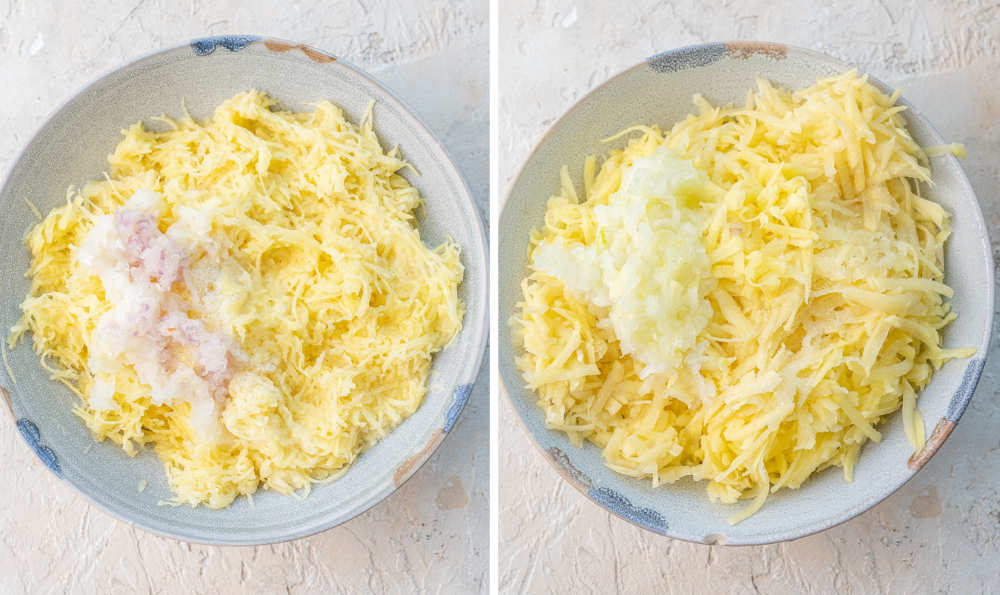
STEP 1: Grate the potatoes.
As mentioned above, you can grate them on the small holes of a box grater, on the large holes, or a little bit of both, just as you prefer. Grate the onion on the small holes of a box grater. Add some salt and stir to combine. Let stand for about 15 minutes for the potatoes to release the excess water.
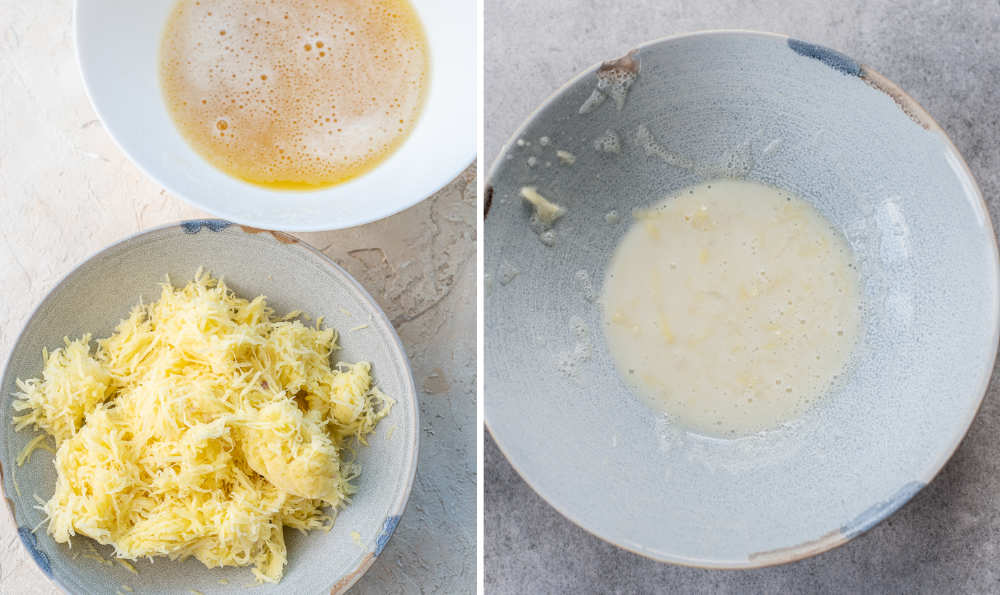
STEP 2: Drain the potatoes
Squeeze out as much water as you can from the potatoes. You can do that by hand or wrap the potatoes in a clean kitchen cloth and squeeze them out. Gather the liquid in a bowl and don’t discard it! Let it stand for 5-10 minutes then carefully discard the water at the top. You will see in your bowl the potato starch (a thick white paste) that will gather at the bottom. You will add that to your grated potatoes.
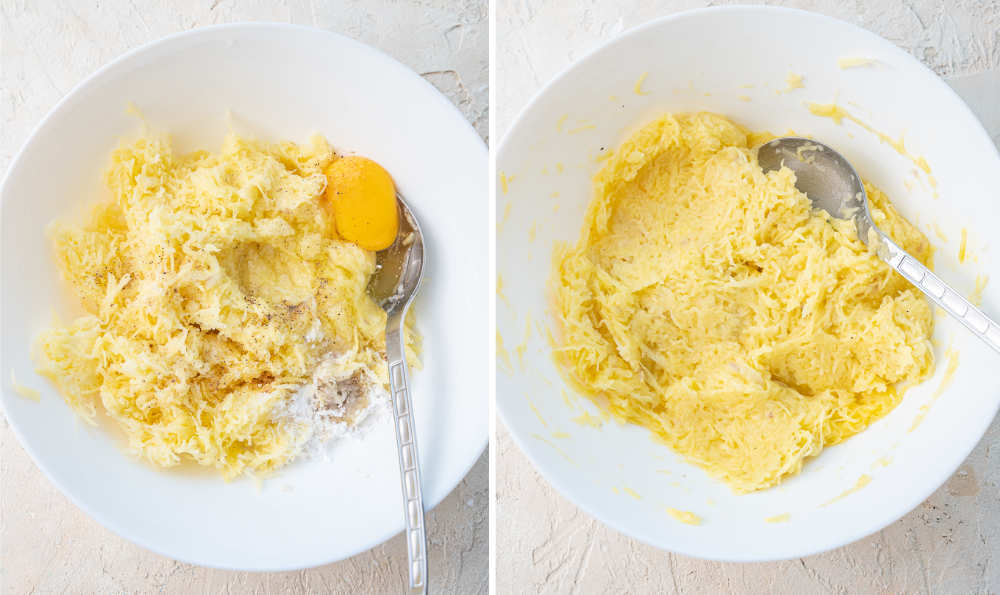
STEP 3: Add your grated and drainer potatoes, potato starch, egg, salt, pepper, and nutmeg into a large bowl.
Stir until combined. That’s your potato pancakes batter.
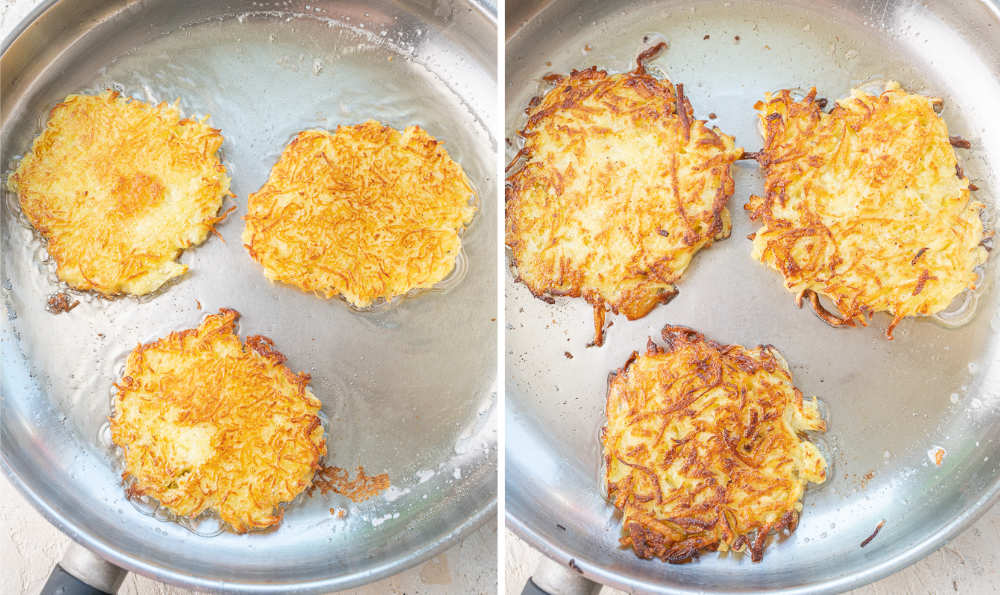
STEP 4: Pan-fry the pancakes
You can see on the left photo potato pancakes grated on the small holes of a box grater, and on the right side – potato pancakes grated on the large holes of a box grater.
Both types of pancakes will be crispy but the pancakes grated on the small holes will be more soft, especially in the middle, and the pancakes grated on the large holes will be more crispy at the edges and in the middle.
How to cook potato pancakes:
Pour a couple of tablespoons of oil into a frying pan over medium or medium-high heat (it depends on how powerful your stovetop is). When your pan is hot enough, scoop about 1 heaped tablespoon of batter per pancake, flatten each pancake into rounds about 1/4 – 1/3 inch (1/2 – 3/4 cm) thick. Cook until golden then flip over and cook on the other side until golden. Don’t cook them over too high heat or they will be browned on the outside but raw in the middle. Transfer to a plate lined with paper towels to drain the excess fat (if you want your pancakes more crispy, drain them on a wire rack).
Enjoy!
How much oil do you need to cook potato pancakes? The amount of oil will depend on how big the pan is. There should be enough oil to cover a minimum of 1/3 of the thickness of the pancakes, and better would be at least 1/2 of their thickness (yes, unfortunately, more oil = more delicious pancakes).
How to keep potato pancakes from falling apart
- squeeze out as much water as possible from the potatoes
- form small round pancakes – smaller pancakes are easier to flip over
- use enough binder (an egg and potato starch) – if your potatoes were more watery and there’s still lots of liquid in the bowl, drain them again or add some flour to the batter
- well heated oil and pan are important
How to serve potato pancakes
- Sour cream
- Apple sauce + sugar (yes, it really is delicious, and works well although it may sound weird)
- mushroom sauce: creamy mushroom sauce or chanterelle mushroom sauce or bacon mushroom sauce (from the recipe for Jägerschnitzel)
- Sour cream + smoked salmon + dill + and optionally caviar
- Goulash
- any kind of meat stew or a dish with gravy
Storage / make-ahead / reheating tips
I have for you some storage and make-ahead tips, but please bear in mind that the best-tasting potato pancakes are made fresh, just after preparing the batter and everything else is second-best.
Can you leave the potato pancakes batter and fry them the next day?
Yes. Cover the freshly prepared batter tightly with plastic foil (the foil should touch the surface of the batter) and put in the fridge for up to 24h. The batter will be very watery on the next day so you need to drain it again very thoroughly (squeeze out the liquid as much as you can) and lightly season again with salt and pepper. The batter will also darken, but you won’t see it after frying the pancakes as they will be just golden from frying. These pancakes will be more oily in comparison to freshly prepared pancakes.
How to store cooked potato pancakes?
Wrap them tightly in plastic foil or put them in a tightly-closed container, and store them in the fridge for up to 48 hours.
How to reheat cooked potato pancakes?
You can either reheat them in an oven preheated to 375°F (190°C) until warm or put them on a dry or just lightly-oiled non-stick pan and cook until warm and crispy (the second option is better but more labor-intensive if you have more pancakes to reheat).
Freezing: The pancakes and the batter can not be frozen. This results in very mushy and tasteless pancakes.
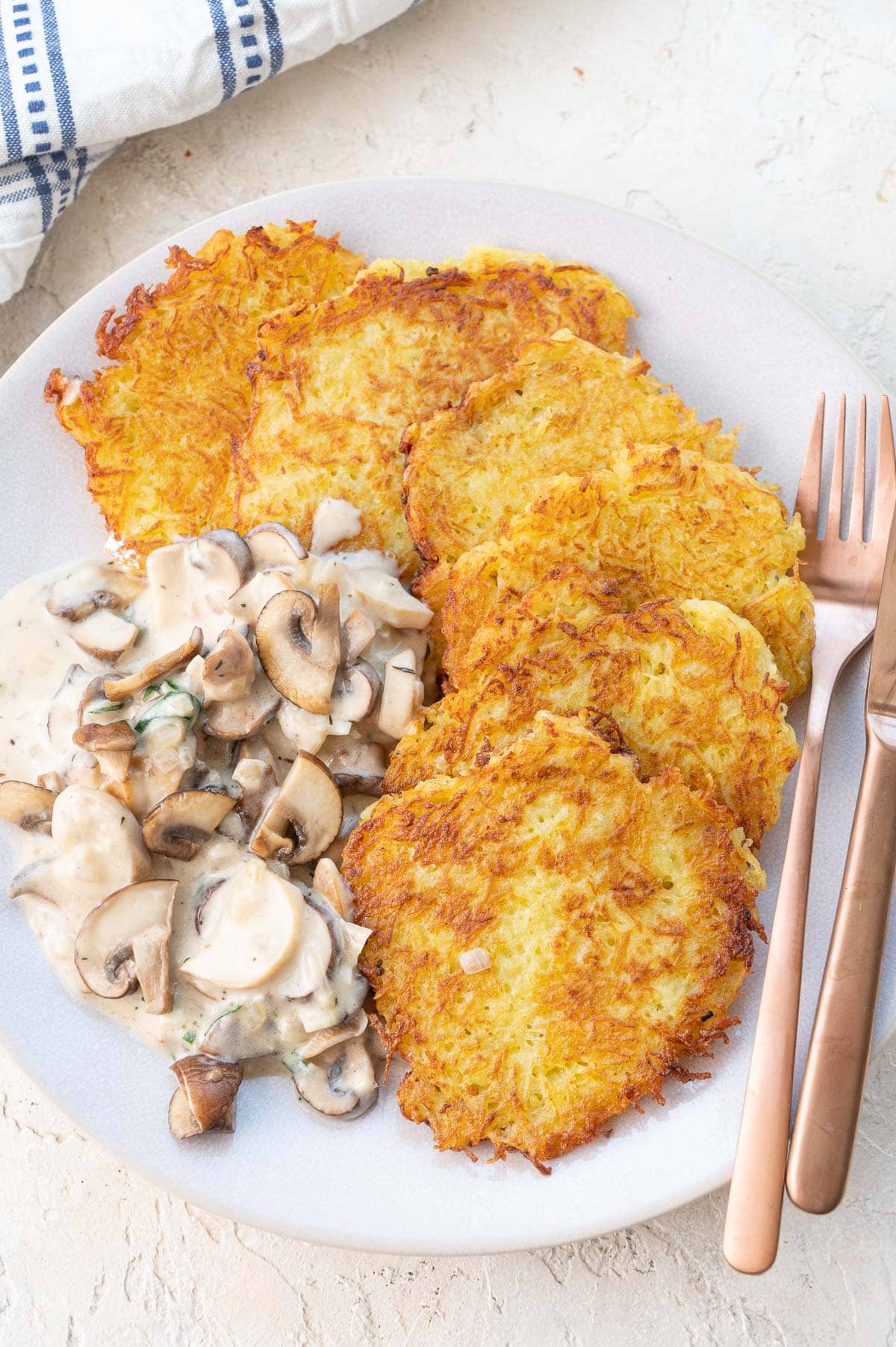
Did you make this recipe? RATE THE RECIPE or tell me in the COMMENTS how you liked it! You can also add a photo of your dish. It would make me very happy and will help other readers. Thank you!!
German Potato Pancakes (Kartoffelpuffer)
Ingredients
for the potato pancakes:
- 1 1/2 pounds (675g) potatoes, Russets or Yukon Gold
- 1 small onion
- 1 egg
- big pinch of nutmeg
- salt and pepper to taste
- frying oil or clarified butter for pan-frying
to serve:
- apple sauce
- sour cream
Would you like to save this?
Instructions
- Grate the potatoes and onion on the small holes of a box grater. Season lightly with salt and let stand for about 15 minutes letting the potatoes release water.
- Squeeze out excess water from the potatoes (either by hand or using a clean kitchen towel) reserving the liquid in a bowl.
- Let the liquid stand for 5 minutes then discard the water at the top. You should see a thick white paste at the bottom – this is potato starch. You will need it for the potato pancake batter.
- Add the grated and drained potatoes, reserved potato starch, egg, and nutmeg to a large bowl. Season the batter with salt and pepper and stir with a spoon until combined.
- Pour a couple of tablespoons of oil into a frying pan over medium or medium-high heat (it depends on how powerful your stovetop is). When your pan is hot enough, scoop about 1 heaped tablespoon of batter per pancake, flatten each pancake into rounds about 1/4 – 1/3 inch (1/2 – 3/4 cm) thick. Cook until golden then flip over and cook on the other side until golden. Don’t cook them over too high heat or they will be browned on the outside but raw in the middle. Transfer to a plate lined with paper towels to drain the excess fat (if you want your pancakes more crispy, drain them on a wire rack).
- Serve with sour cream and/or applesauce.
- Enjoy!
Notes
- If you have forgotten to reserve the water from squeezing the potatoes and you don’t have the potato starch, you can add about 1 tablespoon of store-bought potato starch to the batter.
- How to grate potatoes: it depends on your preferences. You can grate them on the small holes of a box grater, on the large holes of a box grater, or even half on the small and half on the large holes. They are all delicious and a little bit different. I personally prefer the last option. Small holes are more traditional. I don’t recommend blending the potatoes in a food processor/blender to a mash. It can be done but I’m not a fan of such potato pancakes. See for yourself what you like best!
- Calories = 1 serving (1/2 of the recipe). This is only an estimate!

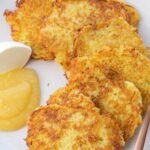
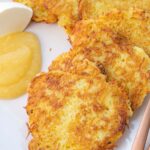
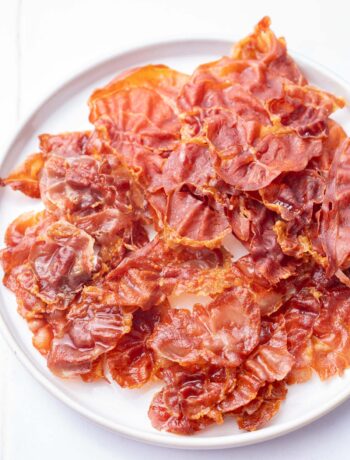
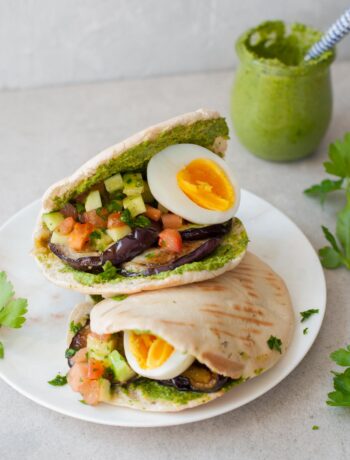
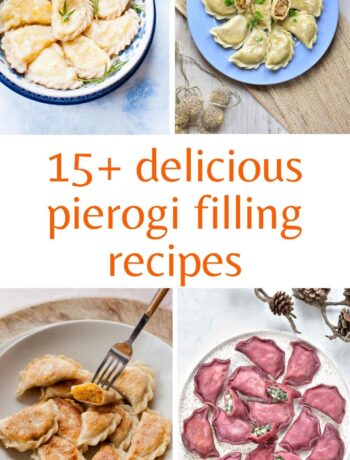
No Comments